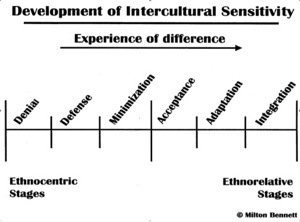Just coming out of an excellent three-day course in Milan with Milton Bennett and Lee Knefelkamp, I could not help myself but to write these couple of sentences down, now that they are still fresh.
I learned that a person’s view on ethics depends heavily on his/her developmental status of learning or knowledge as identified in the so-called “Perry Scheme”.[1] The different positions in this scheme can in turn be very nicely integrated into M. Bennet’s “Developmental Model of Intercultural Sensitivity” (DMIS). The more a person moves up the Perry scheme, the more he/she is open, able to deal with ambiguity and a critical thinker making conscious choices based on active reasoning. The more a person moves from enthnocentrism to ethnorelativism in the DMIS, the more the cultural context will be included in his/her decision making processes and the more culturally appropriate behavior will be part of his/her cultural identity.
Thus in the ultimate stage of development in both models (DMIS and Perry Scheme), considered choices are made in face of legitimate alternatives; the person acts with contextual ethical commitment.
For me, this connection between learning/knowledge, ethics and intercultural communication certainly makes sense and opens up many different ways of exploring the field. Once a group is for example able to deal with difference, which normally happens between “minimization” and “acceptance” in the DMIS and position 5 in the Perry Scheme (constructing meaning), it will certainly add value to sustained innovation and creativity simply by bringing different perspectives into the discussion. Research has indeed shown that heterogeneous, diverse teams who are able to effectively work together (which requires a certain level of intercultural competence) produce much better results than when the teams are composed homogeneously, with people from the same background or with the same values.
Creative innovation is indeed something that many companies nowadays are striving for. The increasing acceleration of technology obsolescence with shrinking lifecycles – paired with an increasingly strict regulatory environment in the medical industry for example – is impacting already the way companies operate. Recent surveys are pointing out that currently the most innovative industries are the ones, which are able to better connect the commercial and technical dots.
And how do you connect these dots? Well, firstly by enabling cross-functional, virtual and multinational teams to effectively communicate and work together. Secondly, companies have to encourage dialogue and creative thinking by signaling that ideas can be tested out, even if sometimes in the end, they are not successful. Incentives and means have to be found to include and anchor not only intercultural competence criteria but also a reward mechanism for constructive disagreement as well as creative idea generation in policies, job descriptions and performance evaluations so that new impulses can be generated.
There is still much to be done here…I am ready, are you?
[1] Perry, W. (1970, 1998) Forms of Cognitive & Ethical Development in the College Years : Knefelkamp, L. « Introduction » ; Moore, W. Overview of the Perry Scheme.



